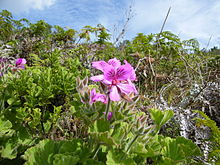Our website is made possible by displaying online advertisements to our visitors.
Please consider supporting us by disabling your ad blocker.
Pelargonium
| Pelargonium | |
|---|---|

| |
| Pelargonium cucullatum | |
| Scientific classification | |
| Kingdom: | Plantae |
| Clade: | Tracheophytes |
| Clade: | Angiosperms |
| Clade: | Eudicots |
| Clade: | Rosids |
| Order: | Geraniales |
| Family: | Geraniaceae |
| Genus: | Pelargonium L'Hér.[1][a] |
| Type species | |
| Pelargonium hirsutum (Burm. f.) Sol. ex Aiton Pelargonium cucullatum[b] (L.) Aiton | |
| Subgenera | |
| |
| Diversity | |
| Around 280 species[4] | |

Pelargonium (/ˌpɛlɑːrˈɡoʊni.əm/)[5] is a genus of flowering plants that includes about 280 species of perennials, succulents, and shrubs,[4] commonly called geraniums, pelargoniums, or storksbills. Geranium is also the botanical name and common name of a separate genus of related plants, also known as cranesbills. Both genera belong to the family Geraniaceae, and Carl Linnaeus originally included all the species in one genus, Geranium; they were later separated into two genera by Charles Louis L'Héritier de Brutelle in 1789.
While Geranium species are mostly temperate herbaceous plants, dying down in winter, Pelargonium species are evergreen perennials indigenous to warm temperate and tropical regions of the world, with many species in southern Africa. They are drought and heat tolerant but can tolerate only minor frosts. Some species are extremely popular garden plants, grown as houseplants and bedding plants in temperate regions. They have a long flowering period, with flowers mostly in red, orange, or white, but intensive breeding has produced a huge array of cultivars with great variety in size, flower colour, leaf form and aromatic foliage.
- ^ William Aiton (1789). Hortus Kewensis. Vol. ii. London: Nicol. p. 417.
- ^ a b van der Walt 1979.
- ^ van der Walt & Vorster 1981.
- ^ a b Cite error: The named reference
powowas invoked but never defined (see the help page). - ^ Sunset Western Garden Book. 1995. pp. 606–07.
Cite error: There are <ref group=lower-alpha> tags or {{efn}} templates on this page, but the references will not show without a {{reflist|group=lower-alpha}} template or {{notelist}} template (see the help page).
Previous Page Next Page


